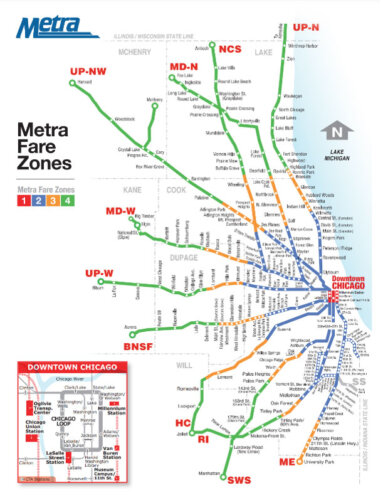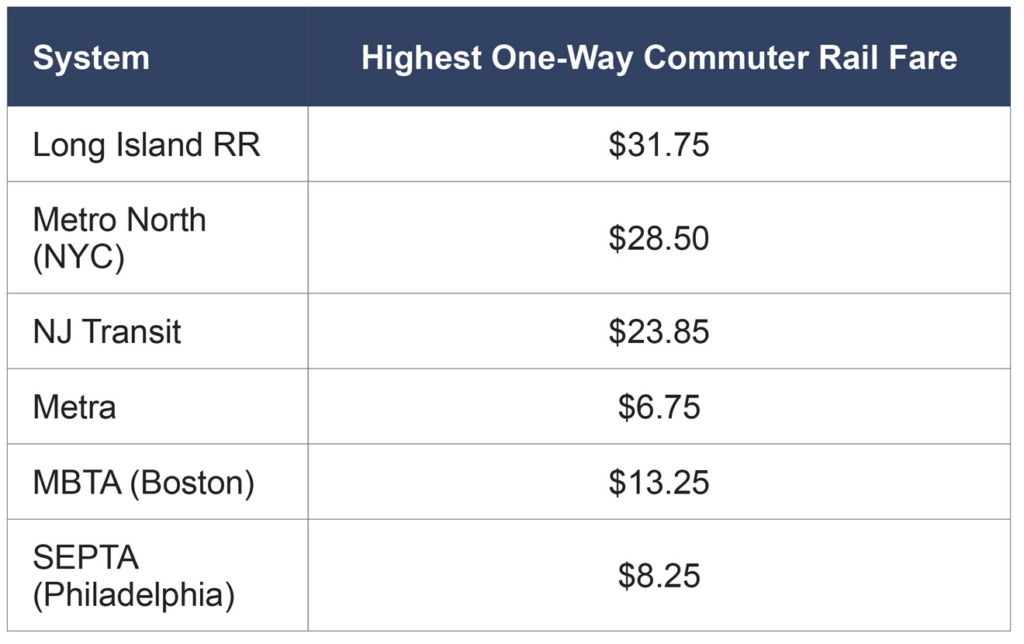Urban-Suburban Transit Fare Comparison
Are suburban residents paying more for their transit service than city residents?
Introduction
Under the leadership of its chair, Senator Ram Villivalam, the Illinois Senate’s Transportation Committee has been holding hearings on public transit issues over the summer of 2024. During these hearings it has been asserted that transit users who are residents of the five collar counties are unfairly paying more for their Metra service than users of the Chicago Transit Authority (CTA). Those who make this assertion point to the fact that Metra commuter rail fares are higher than CTA rail fares. Our research found that transit users in the suburban counties in the Chicago region do not pay more than their fair share compared to CTA transit users.
Background
It is true that Metra fares are the highest transit fares in the region. Metra fares are based on the distance riders travel. Its service area is divided into four zones. It has one-way fares ranging from $3.75 for travel between zones 1 and 2 and between zones 2, 3, and 4 up to $6.75 for travel across all four zones.
 Pace Suburban Bus (Pace) has a flat fare system (meaning riders pay the same amount regardless of how far they ride the bus) and a single ride bus ride costs $2.00. The CTA also has a flat fare system; single ride bus and rail fares are $2.25 and $2.50, respectively.
Pace Suburban Bus (Pace) has a flat fare system (meaning riders pay the same amount regardless of how far they ride the bus) and a single ride bus ride costs $2.00. The CTA also has a flat fare system; single ride bus and rail fares are $2.25 and $2.50, respectively.
Due to a variety of reasons such as reduced fare programs, the average fares for the three service boards are significantly lower than their posted fares:
- CTA: $1.19
- Metra: $4.73
- Pace: $1.30
In 2024, the region will spend about $2.6 billion on transit operating costs (money that supports day-to-day service like bus operators and fuel). COVID relief funds cover $730 million of these operating costs. COVID relief funding will run out in early 2026. The transit agencies will spend $1.6 billion on capital projects in 2024. Ridership in 2024 is projected to be 289 million for CTA, 40 million for Metra, and 15.6 million for Pace.1
1 All financial and ridership information in this post is sourced from: RTA Adopted 2024 Operating Budget, Two-Year Financial Plan, and Five-Year Capital Program. The RTA’s 2025 operating budget should be adopted in December 2024.
Analysis
The assertion that suburban transit users are treated unfairly because their Metra fares are higher than CTA fares does not hold up under scrutiny.
The fact that Metra’s posted and average fares are higher than CTA fares is not in itself a marker of unfairness. Metra uses distance-based pricing and Metra trips tend to be longer than CTA trips. The longest Metra rail line, for example, is double the length of the longest CTA rail line. It costs transit agencies more to provide long trips rather than short trips. That is why the Federal Transit Administration in its National Transit Database uses the time and distance public transit vehicles travel to measure the cost effectiveness of public transit service. Riders expect to pay more for longer trips; just compare the cost of a Chicago to Springfield train trip to a Chicago to Denver trip. Likewise, it is expected that suburbanites, who tend to drive more than city residents, consume more gas and thus pay more in gas taxes than their city counterparts.
Moreover, Metra’s fares are a bargain compared to other commuter rail agencies in the U.S. The highest one-way Metra fare is much lower than the highest fares in all the largest commuter rail systems in the United States:

Metra and CTA fares is less than the gap between commuter rail and city bus/rail fares in these peer metros in both absolute dollars and on a percentage basis.
It is also noteworthy that while Metra’s posted fares are higher than CTA’s posted rail fares, Pace’s posted fares are lower than CTA’s posted bus fares. An approach to the fairness question that looks only at posted fares and ignores the cost of providing the transit service is too simplistic, however.
The finances of the three transit agencies shed light on the fairness question. The General Assembly has long mandated that the three transit agencies collectively recover 50% of their operating costs from fares riders pay; this is called the farebox recovery ratio. The Regional Transportation Authority (RTA) has historically assigned a higher farebox recovery ratio requirement to the CTA than it has assigned to Metra and Pace. This suggests that Metra and Pace users are paying a lower percentage of the cost of their transit service than CTA users pay. MPC tested this hypothesis by deriving the per ride operating and capital cost of CTA, Metra, and Pace transit service. It turns out that the per ride cost of providing CTA service is significantly less than the per ride cost of providing transit service to a Metra or Pace user.
MPC next compared these costs against the average fares paid by the users. It found that Metra users and, especially, Pace users pay a lower percentage of the cost of their transit service than CTA users. MPC finished its analysis by calculating how much higher the Metra and Pace average fares would have to be if their users were required to cover the same percentage of the cost of providing their transit service as CTA users pay. The results of the analysis are as follows:

Note that the Metra and Pace fare increases shown as necessary for Metra and Pace users to cover the same percentage of the cost of their transit service cost that CTA users pay are increases in average fares. Since, as noted above, average fares are significantly lower than posted fares, the increase in posted fares necessary to generate these increases in average fares would be significantly higher than the average fare increases shown above.
Conclusion
The fact that posted Metra fares are higher than CTA fares does not mean that suburban transit suburban users pay more for their transit service than CTA users. CTA users—whose trips originate or terminate in the City of Chicago and approximately thirty other Cook County communities—pay a higher share of the cost of their transit service than Metra and Pace users. Metra users and, especially, Pace users would have to pay significantly higher fares if they were to cover the same percentage of the cost of their transit service as CTA riders pay. When the cost of transit service is factored in, the assertion that suburban transit users pay more than their fair share for public transit is unsupported.
